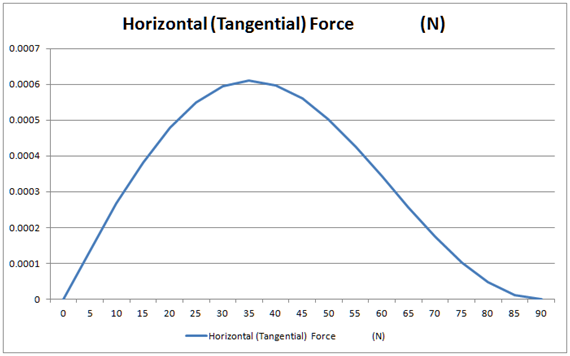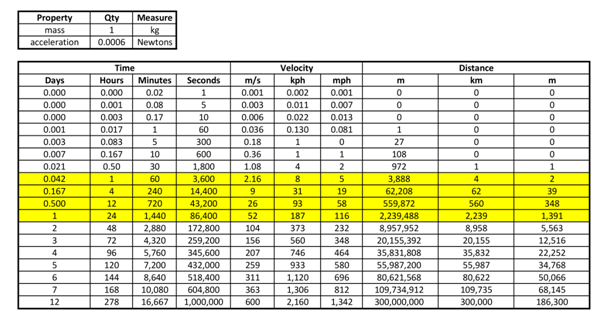It took a while to get here but as you can see, there is a definite curve of tangential force at latitude. Just as a refresher, let’s state specifically what this chart represents. The earth’s atmosphere is constrained in a 60-mile high sphere setting on the earth’s surface. Vertical movement within the atmosphere is limited its 60 mile height. At any point on that sphere horizontal movement is unlimited since traveling around inside the 60 mile high 4,000 mile internal radius sphere simply wraps around after returning to the original spot after traveling about 25,000 miles in any direction. At any point on the sphere’s gravity determines that down is the direction of the sphere’s center and up is the direction away from the sphere’s center. At any point on the sphere horizontal is defined as tangential to the sphere’s surface. Since the atmosphere is limited to the sphere by the earth’s ground and gravity’s influence rotation of the earth about its axis creates a centripetal force perpendicular to the earth’s axis. The physical constraints of ground and gravity causes the force exerted on the atmosphere to vary by the cosine of latitude.

Keep in mind that the center of tornado activity corresponds to the latitude of maximum tangential force. This includes areas around areas such as Norman Oklahoma and North Alabama, North Mississippi, North Louisiana and North Texas.
This curve is the horizontal force on the atmosphere due to centripetal force. In short, it is the artificial gravity created by the spinning of the earth on its axis and constraints of atmospheric limits.

After we have the problem solved for centripetal force, we must then scale the horizontal (tangential) weather force to compensate for atmospheric buoyancy. Applying the low atmospheric density-differential (buoyancy) of about 5% between hot-humid air and cold-dry air makes the resulting horizontal (tangential) force seem miniscule, especially when compared to vertical (perpendicular to the surface) effects controlled by earth’s gravity. See the Appendix on Centripetal (Horizontal) buoyancy for details regarding buoyancy calculation.
The ratio of mass to buoyancy is the same for vertical and horizontal weather. The difference is that the vertical field is earth’s gravity. The horizontal field is centripetal force, which is much smaller. The primary difference is that vertical effects operate over feet and minutes while horizontal weather is in terms of furlongs and fortnights.
Centripetal force is minimal near the poles because the surface path is small at those latitudes. Centripetal force is maximal at latitudes near the equator due to high surface speed but the horizontal (tangential) effect approaches zero. Solving the combination of surface speed and tangential effects illustrates horizontal weather effects at various latitudes.
Referring to the table below note that the “miniscule” horizontal (tangential) weather force will accelerate objects to well over 50 miles per hour in half a day. I’ve colored the one hour to twenty four-hour hoour durations because they seem to be in a reasonable range.
The buoyancy differential between dry-cold air and hot-humid air will rarely be 4% making these velocities and distance calculations only barely representative. However, since I live in an area very near the horizontal (tangential) force peak (about 35 degree latitude) and the flat great planes between me and the source of North American cold air, I think this is certainly adequate justification to pursue this line of inquiry!
One kilogram of air accelerated by .0006 Newtons for 12 hours or 1/2 day will accelerate to 26 meters per second as it travels 560 kilometers. These numbers seem to be in the ballpark.
Now consider that air will not begin movement from a standing start. In the middle latitudes there is continuous continental air movement especially during spring and fall.
Take the Time-Velocity-Distance for Tangential Weather Forces chart with a grain of salt. There are many sources to air resistance, the greatest of which is turbulence. Horizontal turbulence (with a vertical axis of rotation) accounts for the counter clockwise twirls we call low-pressure areas. There is also vertical turbulence (with a horizontal axis of rotation) created above the dominant airflow. Turbulence decreases velocity and distance traveled greatly.
These numbers are reasonable and self-sufficient.
These numbers are also conservative. Cold-dry air can be much colder and warm-moist air can be more buoyant. Circulation is constant without requiring initial acceleration.
Next Perspective
Back Real World
